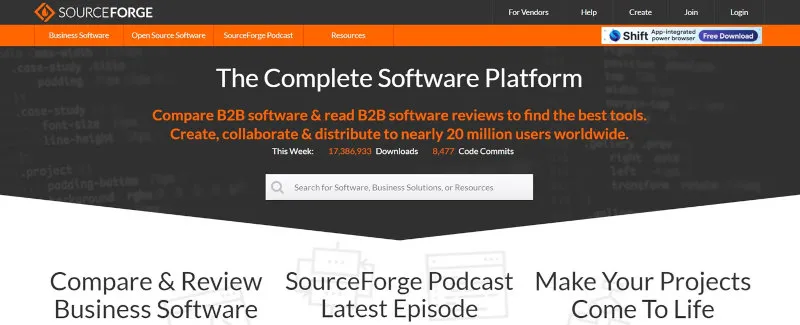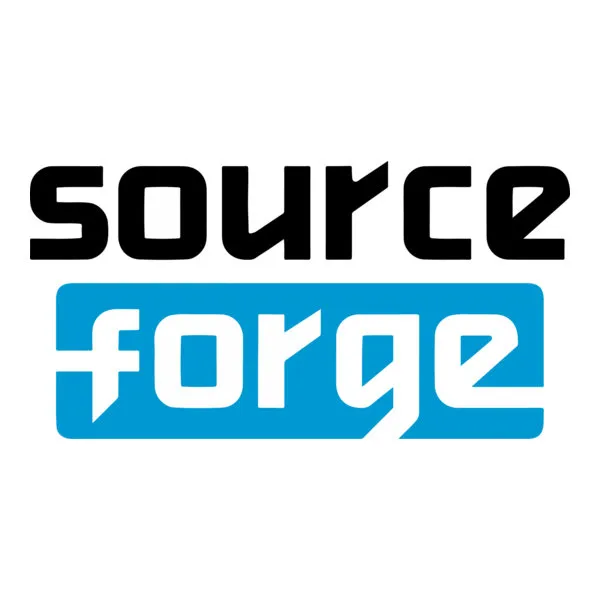
SourceForge is the Legendary Open-Source Hub
Table of Contents
- Key Features at a Glance
- The SourceForge Philosophy: Who Is It For?
- GitHub vs. SourceForge: A Quick Comparison
- Pros and Cons
- How SourceForge Works: A Technical Overview
- Use Cases and Real-World Applications
- Getting Started & Further Reading
- FAQ
- Conclusion
Long before GitHub became the center of the developer universe, there was SourceForge. Launched in 1999, it was the original, definitive platform for open-source projects, providing a free home for code, downloads, and collaboration. For an entire generation of developers, SourceForge was synonymous with open source.
Today, while the developer workflow has largely shifted to platforms like GitHub, SourceForge has evolved. It remains a massive and highly trafficked directory and distribution platform for open-source software. It’s an alternative less focused on the modern DevOps lifecycle and more on providing a stable, high-visibility home for project releases and community tools.
Key Features at a Glance
SourceForge offers a classic, all-in-one suite of tools for open-source project management and distribution.
| Feature | Description | Key Benefit |
|---|---|---|
| File Release System | This is SourceForge’s core strength today. It provides a globally distributed, high-availability network for hosting project downloads (binaries, installers, etc.). | Offers projects a reliable and fast way to deliver their software to millions of end-users, complete with download statistics. |
| Multi-VCS Hosting | Provides hosting for Git, Subversion (SVN), and Mercurial (Hg) repositories. | Accommodates a wide range of projects, including legacy ones that have not migrated to Git, offering them a stable, long-term home. |
| Classic Community Tools | Each project can enable a suite of traditional tools: an issue tracker, discussion forums, and mailing lists. | Provides a self-contained community hub for users and developers to interact, report bugs, and discuss the project. |
| Project Webspace | Offers free web hosting for project pages, allowing teams to create a simple homepage for their software. | Gives every project a free, customizable web presence without needing to manage separate hosting. |
The SourceForge Philosophy: Who Is It For?

SourceForge’s modern philosophy is centered on software distribution and project discovery. It’s less about the moment-to-moment developer workflow and more about connecting open-source projects with their end-users.
This makes it a relevant choice for:
Open-Source Maintainers Needing Distribution: If your primary need is a reliable place for millions of users to download your releases, SourceForge’s network is hard to beat.
Legacy Projects: Projects that have been on the platform for years and have an established community and workflow find it to be a stable home.
Projects Seeking Visibility: As a massive software directory, being listed on SourceForge can significantly increase a project’s visibility to potential users.
All-in-One Simplicity: Teams that want a single, free place to host their code, downloads, and forums without the complexity of modern DevOps platforms.
GitHub vs. SourceForge: A Quick Comparison
The contrast between the two platforms highlights the evolution of the open-source landscape.
| Aspect | GitHub | SourceForge |
|---|---|---|
| Primary Focus | Developer collaboration, CI/CD, and the “pull request” workflow. | Software distribution, project discovery, and end-user downloads. |
| User Experience | Modern, fast, developer-centric UI focused on code. | A more traditional, directory-style UI focused on project pages and downloads. |
| Business Model | Freemium SaaS model with paid tiers for teams and enterprises. | Primarily ad-supported on project and download pages. |
| CI/CD | Integrated, powerful GitHub Actions. | No integrated CI/CD solution. |
Pros and Cons

Why You Might Choose SourceForge
Massive Distribution Network: Its file release system is robust, globally mirrored, and capable of handling immense traffic, which is a huge benefit for popular projects.
High Visibility and SEO: SourceForge project pages rank very well in search engines, helping users discover your software.
Completely Free: It offers a comprehensive suite of tools—code hosting, downloads, tracker, forums—at no cost to the project.
Longevity and Stability: It is one of the oldest and most established platforms, providing a stable home for long-term projects.
Potential Drawbacks
Ad-Supported Model: The presence of ads on download pages is a significant difference from GitHub and has been a point of controversy in the past, particularly concerning bundled installers in a now-discontinued program.
Dated User Interface: The UI, while functional, does not have the modern look, feel, or speed of its more contemporary competitors.
Lacks Modern DevOps Features: It is missing key components of a modern workflow, such as integrated CI/CD, container registries, or advanced security scanning.
Shift in Developer Gravity: The core of active, collaborative open-source development has largely migrated to platforms like GitHub and GitLab, making SourceForge more of a distribution endpoint than a development hub for many new projects.
How SourceForge Works: A Technical Overview

SourceForge operates as a cloud-hosted platform designed to support open-source project management and distribution. Here’s a breakdown of its technical functionality:
-
File Release System: SourceForge’s standout feature is its globally distributed content delivery network (CDN) for hosting project releases. Projects can upload binaries, installers, or source archives, which are mirrored across servers worldwide for high availability and fast downloads. The platform provides detailed download statistics, helping maintainers track user engagement.
-
Version Control Hosting: SourceForge supports Git, Subversion (SVN), and Mercurial (Hg) repositories, accessible via a web interface or standard VCS clients. Repositories are managed through a project dashboard, allowing maintainers to configure access and track activity.
-
Community Tools: Each project can enable tools like issue trackers for bug reporting, discussion forums for community interaction, and mailing lists for announcements. These tools are integrated into the project’s SourceForge page, creating a centralized hub.
-
Project Webspace: SourceForge provides free web hosting for project homepages, supporting HTML and basic customization. This allows projects to create a public-facing presence without external hosting costs.
-
Analytics and Visibility: The platform’s directory is optimized for search engine indexing, increasing discoverability. Projects are categorized and tagged, making it easy for users to find relevant software.
This architecture prioritizes simplicity and accessibility, catering to projects that value distribution and community engagement over modern DevOps workflows.
Use Cases and Real-World Applications
SourceForge’s strengths make it suitable for specific scenarios, particularly for open-source projects focused on distribution and visibility. Here are some practical examples:
-
Popular Open-Source Software Distribution: A project like Audacity, a widely used audio editing tool, leverages SourceForge’s file release system to distribute installers to millions of users globally, benefiting from the platform’s robust CDN and download analytics.
-
Legacy Open-Source Projects: A project using SVN, such as an older Linux utility, remains on SourceForge to maintain its established community and workflow, avoiding the need to migrate to Git or another platform.
-
Niche Software with Broad Reach: A specialized tool, like a scientific data analysis package, uses SourceForge’s directory to gain visibility among researchers, with its project page serving as a central hub for downloads and user support forums.
-
Hobbyist and Small Team Projects: A small team developing a free game mod hosts its code, releases, and community discussions on SourceForge, taking advantage of the free tools and webspace to avoid managing separate infrastructure.
These use cases demonstrate SourceForge’s role as a reliable distribution and discovery platform for diverse open-source projects.
Getting Started & Further Reading
Ready to explore one of the founding platforms of the open-source movement? Check out the official resources.
Official Website: https://sourceforge.net/
Create a Project: https://sourceforge.net/create/
Open Source Software Directory: https://sourceforge.net/directory/
SourceForge Support: https://sourceforge.net/support
FAQ
What types of version control systems does SourceForge support?
SourceForge supports Git, Subversion (SVN), and Mercurial (Hg), allowing projects to host repositories using any of these systems.
Is SourceForge completely free to use?
Yes, SourceForge is free for open-source projects, providing code hosting, file releases, community tools, and webspace at no cost, though it is ad-supported.
Does SourceForge offer CI/CD capabilities?
No, SourceForge does not provide integrated CI/CD tools. Projects needing CI/CD must integrate with external platforms like Jenkins or GitHub Actions.
How does SourceForge ensure high download availability?
SourceForge uses a globally distributed content delivery network (CDN) to host project releases, ensuring fast and reliable downloads for users worldwide.
Is SourceForge suitable for modern DevOps workflows?
SourceForge is better suited for distribution and project discovery rather than modern DevOps, as it lacks features like integrated CI/CD, container registries, or advanced collaboration tools.
Conclusion
SourceForge is a legend of the open-source world, and while it may no longer be the primary arena for active development, it has successfully carved out a vital new role. It stands as a powerful distribution platform and software directory. For project maintainers who need to get their releases into the hands of users reliably and at scale, SourceForge remains an incredibly relevant and powerful option, bridging the gap between developers and the millions of people who use their software.